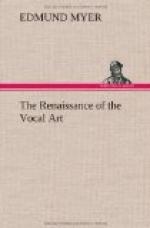In presenting these ideas to my readers, I realize how difficult it is to put them in words, and how much they lose when they appear in cold print. In working with a living, vitalized voice, the effect is so different. The reader who may desire to experiment with these ideas should place himself before a mirror, and make his image his pupil, his subject. In this way he can better study the movements, the action, the position, the level of the tone, and the breathing.
In private teaching, of course, we do not take up one subject or principle and finish that, and then take up the next one; but one idea is constantly built upon another to form the harmonious whole. The formula which we use here, as we have said, is the one adopted for the normal class at the Point Chautauqua summer school. This we do in order to have the system properly arranged for lecture, illustrations, and for a practical study of the devices, not only from the singer’s, but from the teacher’s standpoint as well.
The teacher or singer who studies and masters this course never questions or doubts the truth and power of automatic breathing and automatic breath-control; or the wonderful influence on the voice of these movements, which we call true position and action in singing.[1]
[Footnote 1: The few exercises or studies here given, as well as a number of others, may be found fully carried out with accompaniment, in “Exercises for the Training and Development of the Voice,” by the author of this work. Published by William A. Pond and Company.]
ARTICLE THREE.
THE THIRD PRINCIPLE OF ARTISTIC TONE-PRODUCTION.
The third principle of artistic tone-production is
High Placing and Low Resonance.
Theory.—Tone, to be artistic, must be placed forward and high, and must be reinforced by the low cavities and chest resonance; it must be placed high, and reinforced or built down by added resonance through expansion and inflation.
Devices.—Place high by removing all restraint, all obstruction, through flexible movements. The high, forward placing is the natural focus of the voice. When the voice is thus placed and automatic control prevails, reaction and reflection occur, and the sympathetic low resonance of the inflated cavities is added to the tone. Also study the naturally high placing of E and the naturally low color of oo; then equalize all the vowels through their influence, and thus develop uniform color and quality in all.
This third principle of artistic singing is a very important one, and means much more than one might, at first thought, suppose. Many singers think of placing simply as the point of contact or impact of the air current. Placing, however, means more than this. It means not only the correct focus of tone forward and high, but it also means reaction and reflection of the air current; in short, sympathetic added vibration of air in the low inflated cavities. This being true, we find that correct placing means even much more. It means the true form and adjustment of all the parts—all true conditions of tone.




